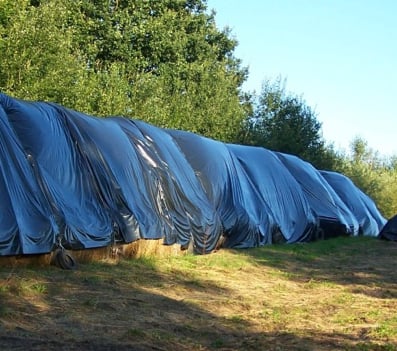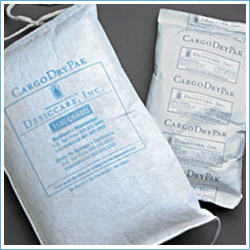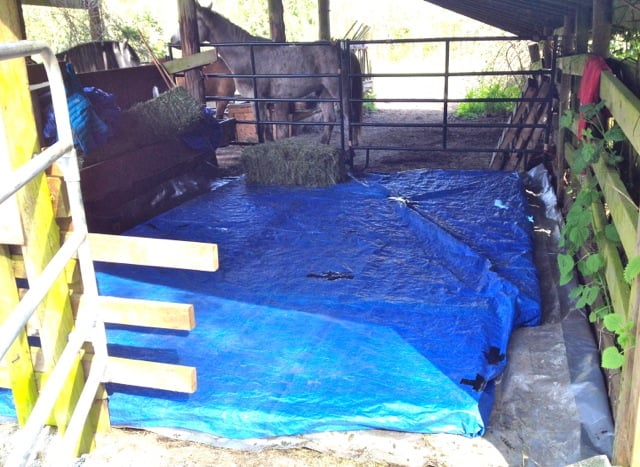How To Keep Hay From Molding

We've all heard nigh the different ways you tin can cover your hay stack with a tarp and so it doesn't get wet or moldy.
But accept you ever heard about using commercial-size dessicant pouches to absorb moisture nether your hay tarp? Idea not. Neither had I, until I met an innovative equus caballus-owning couple, Sandy and Roger, who as well endemic a packaging business!
If you're wondering what dessicant pouches are – they are the absorptive little packets manufacturers put into supplement bottles, electronics, certain packaged foods, and anything else that can be degraded by wet. They are often made of substances similar silica gel, activated charcoal, and bentonite clay. What does this have to practice with keeping hay dry out and not-moldy? Well, these dessicant pouches likewise come in large bags, that are used inside containers shipped to Asia.
 The dessicant bags that Sandy and Roger hang in their barn are 1500 gm Cargo Dry Paks. They come in boxes of 10 and you'll need to use v paks or bags per year. If you lot want to purchase from them in Canada at Buyer's Packaging in Delta, BC, exist sure and mention that you want to employ the dessicant paks to protect your hay – they give horse people a substantial discount over regular customers!
The dessicant bags that Sandy and Roger hang in their barn are 1500 gm Cargo Dry Paks. They come in boxes of 10 and you'll need to use v paks or bags per year. If you lot want to purchase from them in Canada at Buyer's Packaging in Delta, BC, exist sure and mention that you want to employ the dessicant paks to protect your hay – they give horse people a substantial discount over regular customers!
If yous want to buy from the States, you can purchase the same 1500 one thousand Cargo Dry out Paks on Amazon. The smashing thing about this brand (Cargo Dry Paks) is they can only be thrown in the garbage when they're used up (natural ingredients), and they come with the necktie-strings attached (so you tin easily necktie them to the poles – run across below). Note: When toll shopping for these dessicant bags, be sure to check the shipping charges – the price of shipping is oft equal to the cost of the bags, because they're so heavy.
How To Gear up Up Super Dry Hay Storage
If y'all need to store your hay in an open field, or under a pole barn, or some other structure that is non completely enclosed, follow these instructions to create a completely enclosed, dry, protected hay storage area; using only tarps, wooden pallets, commercial-sized dessicant numberless, and a few poles.
Notation: This method works best for hay that is going to be stored for a while – not for your active hay stack that yous're pulling bales from every day. For active/temporary hay storage, see the section farther downward.
Stride 1: Cover the area you are going to identify your hay on with wooden pallets. Then cover the wooden pallets with a basic bluish poly tarp that extends at to the lowest degree 3 feet beyond the perimeter of your hay stack, on every side (you'll need this extra length in Step iii). The ground tarp prevents wet from coming upward from the basis and into your hay.
Step 2: Stack your bales in a pyramid/cone shape so that whatsoever water runs easily down and off. Here'south a trick my Dad figured out: Take a bunch of rectangular Lego pieces – designate 1 piece of Lego for each bale. Figure out the ground area you lot have and set upwardly your lego/bales to cover the total area. Then experiment with how to build your stack of hay bales. Bring your finished Lego stack model with you when your hay arrives and testify it to the guy unloading the hay – a visual is MUCH easier to understand and will save you 10 minutes of explaining!
Step 3: After your hay is stacked properly, yous bring the sides of the lesser tarp up and tuck them into the lower bales, or, tie the tarp so it stays wrapped up the sides of the bales. Now you know why you need at least three′ of extra tarp extending across your hay stack on all sides. If yous left the bottom tarp flat on the pallets, water would eventually run from the edges of the tarp into your hay stack. I don't accept a picture of what this looks similar on a big hay stack, simply here's what it looks similar on a smaller stack – y'all can see how I've used bungee cords to secure the sides of the tarp up around the bales:

Footstep 4: Now information technology's time to create a tent using a UV resistant, 100% waterproof hay tarp (see below for specs and purchasing details). You need to use a hay tarp that is big enough to encompass your entire stack, loosely (y'all need to go out room to hang the dessicant numberless – run into Step v), all the way to the basis, and then tuck in underneath your bottom layer of bales, at least a 6″ flap tucked in. The goal is to create a completely enclosed, water tight storage tent.
Notation: You can only completely enclose a hay stack if the hay has already been off the field and left to dry out completely (usually ane month from cutting). Otherwise, the heat still in the hay will condense, resulting in moisture trapped in your hay tarp tent, which can and so cause moldy hay. If your hay is not completely dry, so merely comprehend the height and part-way down the side of the stack, until your hay is dry.
Footstep v: Set up your commercial-sized dessicant bags (1500 grams, approx. 6″x12″) inside your hay tarp tent. Sandy and Roger (mentioned above) told me they have experimented with numerous unlike placements and the best style is to hang each pocketbook from a pole, spaced evenly around the stack. They use 5 numberless, which terminal the whole year. You can encounter when the dessicant bags are used upwards, considering the water starts to drip out of them. You cannot dry them out (they've tried!), you lot just need to throw them away when they've striking their moisture capacity.
You tin can erect 5 poles that come upwards from the footing effectually your hay stack, and then tie the numberless to the top of each pole. Simply that is too difficult for me (I'm no Bob the Architect), so instead I placed poles horizontally across my hay stack, 2 rows from the peak. The bales on top held the poles in place with their weight. I jutted the poles out about 14″ from the side of the closest bale and tied my dessicant sacks to the cease of the poles with the necktie-strings. Voila! I establish it easiest to buy 4′ long metallic poles from Abode Depot.
When I desire to remove a bunch of hay from my tarped stack, I simply open up one side – by pulling the cover tarp out from where it is tucked underneath the bales, and releasing the footing tarp on that side. I remove the bales, then bring the basis tarp up over the sides once again, and tuck the cover tarp back underneath the bottom bales over again.
Storing Hay In An Enclosed Befouled or Shed
Of course, if you have an enclosed befouled or shed to store hay in, you don't need to tarp at all – then y'all tin only hang the dessicant bags on poles around your hay stack, or hang them from the ceiling.
If your barn is open for airflow, y'all can stack lower-priced "sacrifice bales" against the opening to cake nigh of the current of air/pelting, simply withal allow for some airflow. This is what Sandy and Roger do in their befouled – combined with the hanging dessicant bags, they take not had ONE moldy bale since they discovered this system of hay storage 12 years ago. And yes, they alive in the super wet, super rainy Pacific Northwest (Langley, BC).
Purchasing Inexpensive only Good Quality Hay Tarps
In my search for the best deal on a large hay tarp that would fully embrace 65 bales and constrict in underneath them, all the way round, I compared both price and quality from 4 unlike tarp supply companies. This is no small task as you demand to write down the weight per square one thousand, the denier, the weave count, and the material for every tarp you compare pricing on. You lot likewise need to make certain the tarp is 100% Waterproof (not simply water-resistant), UV resistant, and it is squeamish if it is acid resistant, tear resistant, and has arctic flexibility (although this concluding one is a must if yous get cold winters).
It really pays to do your inquiry as prices for exactly the same tarp could exist anywhere from xxx% – fifty% higher, depending on which supplier's site I was on.
And and so I discovered some other trick – y'all're going to love this i! I was on TarpsPlus.com (which had the cheapest tarps) and I discovered that tarp companies can listing pretty much the same tarp, but in a unlike category, and charge completely dissimilar prices for it!
And so I'm in the Hay Tarp section and Ane 25'x33′ human foot hay tarp costs $189. Then I click over to the Gym Floor Cover section (because my daughter's a gymnast and I got curious) and lo and behold, I can buy 2 20'x30′ tarps for only $192. And the specs are very similar – so similar, I'll bet I couldn't tell the difference betwixt them if they were lying side by side! The main departure is the hay tarp is eight.5 oz per foursquare yard, and the gym tarp is 8 oz per foursquare k. Crazy hey? Only, if yous're willing to drop to 6 oz per foursquare m, you can get those aforementioned Ii 20'x30′ tarps in the Poly Tarps section for simply $168! And yes, you tin buy them singly every bit well.
What SIZE Tarp Exercise I Demand To Cover My Hay Bales?
Oh, hither's where things get difficult! Specially if yous're not a math whiz.
The easiest way to figure out what size tarp you need to get is to telephone call your hay farmer and ask, "If I'k going to stack 10 bales from you, in a pyramid shape (so the rain runs off), what size tarp do I need to comprehend the unabridged stack downwardly to the basis, with near 6″ free to tuck in all around the sides of the stack?" This is considering hay farmers are commonly pretty familiar with tarping hay stacks and can probably guesstimate better than yous can. Then just add together ii′-3′ on to each side to allow for the hanging dessicant numberless (run into Footstep 5 above).
The harder, but possibly more accurate way to determine what size tarp you demand, is to become the width, depth and height measurements of your hay bales. Build your Lego model (see Stride two above) and and so apply the real hay bale measurements to figure out the real size your hay stack will be. You tin delegate this task to whatever math whiz you know and she/he volition be able to figure it out. Again, and so add 2′-three′ on to each side to allow for the hanging dessicant bags (see Footstep 4 higher up). Don't accept whatsoever Lego? Oy vey, well at present you're going to accept to draw your hay stack model – easiest if you lot print off some graph paper and brand ane′ = one square on the paper. Y'all may accept to tape a few sheets of graph newspaper together, depending on how many bales you have.
Storing Hay In Utilize For Daily Feeding
For a hay stack you are in and out of daily to feed your horses, yous do not need to employ the dessicant pouches.
If your hay is in a field, or pole barn (roof only) you are going to accept a hassle getting in and out of your hay stack every day, since you need to wrap it up really well to prevent rain being blown into your hay stack. Y'all can reduce the hassle a chip by just opening ane corner of the stack at a fourth dimension. So when your storage does not have walls or a roof, you need to lay down pallets, then place a ground tarp over the pallets and pull it up on the sides of your bales:

Then you place another tarp over top of the bales and tie it (and weight it down if needed) to foreclose the current of air blowing it off:

All the same, if your hay is in a more enclosed befouled (with some walls and a roof) and then I establish it works fine to put a thick tarp (similar those used to cover RV/campers) correct on the footing, then lay pallets on top of the tarp, and then encompass the pallets with some other tarp, then stack your hay, and then put a third tarp to cover your hay stack:

You can either necktie the top tarp firmly around the stack (to prevent the air current bravado information technology off) or, you can lean actress pallets against the sides – which I detect easier. If you don't want to comprehend your pallets with a 2nd tarp, and so you are going to have a lot of hay wastage. If you lot live in a damp climate, the hay that drops into the pallets will get moldy in a few months time and you volition have to clean out your unabridged storage (and the pallets!) and start over again. If your horses are eating through your hay stack within 3-4 months, this method works great.
In my research, I read many reports from people who were buying an entire winter's worth of hay for several horses all at one time – so storing a huge volume. The consensus in that case seemed to be that y'all put the tarp on the basis, then the pallets. But you don't put another tarp on summit of the pallets, because that will block the airflow. They said it worked better to put a bottom layer of cheap hay or harbinger (every bit the lesser layer will e'er become some mold), and then your good hay. And of course, encompass the whole stack with another tarp over the top and sides.
One last tip: When yous are stacking your hay for long-term storage, Dwain Meyer from North Dakota Land Academy recommends this method:
"Stack bales for air apportionment. Large foursquare bales should have a 4-6" gap between bales to increment air circulation for both indoor and outdoor storage and allows for the natural hay sweating procedure. Place the bottom layer of small square bales on their sides and then the uneven, non-stringed surface rests on the floor (if pallets are not used) to aid air circulation throughout the stack. Exit infinite betwixt the bales in each row and alternating the orientation of successive layers so bales are at right angles with layers above and beneath. This pattern "ties" the stack together, while as well keeping bales from packing together also tightly. Rows of large round bales should be separated past 3-4' to aid air circulation."

Jini Patel Thompson is a natural health author and Lazer Borer instructor. She began riding at age ii in Republic of kenya, and got her first horse at historic period 8 in Alberta, and so continues a life-long journeying and love affair with these amazing creatures.
Source: https://listentoyourhorse.com/storing-hay-so-it-never-gets-moldy/

0 Response to "How To Keep Hay From Molding"
Post a Comment